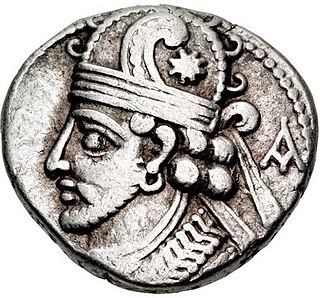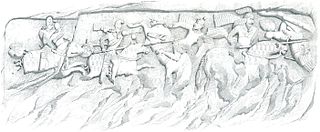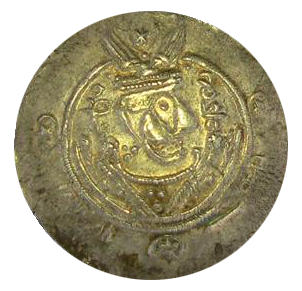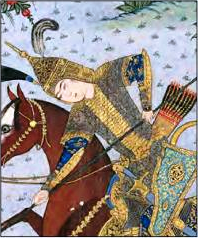The 210s decade ran from January 1, 210, to December 31, 219.
The 220s decade ran from January 1, 220, to December 31, 229.

Atropatene, also known as Media Atropatene, was an ancient Iranian kingdom established in c. 323 BC by the Persian satrap Atropates. The kingdom, centered in present-day northern Iran, was ruled by Atropates' descendants until the early 1st-century AD, when the Parthian Arsacid dynasty supplanted them. It was conquered by the Sasanians in 226, and turned into a province governed by a marzban ("margrave"). Atropatene was the only Iranian region to remain under Zoroastrian authority from the Achaemenids to the Arab conquest without interruption, aside from being briefly ruled by the Macedonian king Alexander the Great.

Artabanus IV, also known as Ardavan IV (Parthian:𐭓𐭕𐭐𐭍), incorrectly known in older scholarship as Artabanus V, was the last ruler of the Parthian Empire from c. 213 to 224. He was the younger son of Vologases V, who died in 208.

Artabanus II, incorrectly known in older scholarship as Artabanus III, was King of Kings of the Parthian Empire from 12 to 38/41 AD, with a one-year interruption. He was the nephew and successor of Vonones I. His father was a Dahae prince, whilst his mother was a daughter of the Parthian King of Kings Phraates IV

Pacorus II was the King of Kings of the Parthian Empire from 78 to 110. He was the son and successor of Vologases I.

The Parthian Empire, also known as the Arsacid Empire, was a major Iranian political and cultural power centered in ancient Iran from 247 BC to 224 AD. Its latter name comes from its founder, Arsaces I, who led the Parni tribe in conquering the region of Parthia in Iran's northeast, then a satrapy (province) under Andragoras, who was rebelling against the Seleucid Empire. Mithridates I greatly expanded the empire by seizing Media and Mesopotamia from the Seleucids. At its height, the Parthian Empire stretched from the northern reaches of the Euphrates, in what is now central-eastern Turkey, to present-day Afghanistan and western Pakistan. The empire, located on the Silk Road trade route between the Roman Empire in the Mediterranean Basin and the Han dynasty of China, became a center of trade and commerce.

The Battle of Hormozdgan was the climactic battle between the Arsacid and the Sasanian dynasties that took place on 28 April 224. The Sasanian victory broke the power of the Parthian dynasty, effectively ending almost five centuries of Parthian rule in Iran, and marking the official start of the Sasanian era.

Parthia is a historical region located in northeastern Greater Iran. It was conquered and subjugated by the empire of the Medes during the 7th century BC, was incorporated into the subsequent Achaemenid Empire under Cyrus the Great in the 6th century BC, and formed part of the Hellenistic Seleucid Empire after the 4th-century BC conquests of Alexander the Great. The region later served as the political and cultural base of the Eastern Iranian Parni people and Arsacid dynasty, rulers of the Parthian Empire. The Sasanian Empire, the last state of pre-Islamic Iran, also held the region and maintained the seven Parthian clans as part of their feudal aristocracy.
The Daylamites or Dailamites were an Iranian people inhabiting the Daylam—the mountainous regions of northern Iran on the southwest coast of the Caspian Sea, now comprising the southeastern half of Gilan Province.

Mihr Hormozd was an Iranian nobleman from the House of Suren. He was the son of Mardanshah, the padgospan of Nemroz, who was later executed by the orders of the Sasanian king Khosrau II. In 628, Khosrau was overthrown by his son Kavadh II, and was taken to prison, where he was shortly executed by Mihr Hormozd who sought to avenge his father's death. However, after the execution, Kavadh had Mihr Hormizd killed.

Muta was a 7th-century Daylamite king, who fought against the Arabs in the battle of Waj Rudh. He was, however, defeated and killed by Nu'aym ibn Muqarrin.

The Principality of Ushrusana was a local dynasty ruling the Ushrusana region, in the northern area of modern Tajikistan, from an unknown date to 892 CE. Ushrusana, just like Ferghana, did not belong to Sogdia proper, but its inhabitants wrote in Sogdian, and may have spoken the Sogdian language as well. The rulers of the principality were known by their title of Afshin.
Shadh-Shapur was an Iranian king who ruled Spahan and its surroundings as a vassal of the Parthian Empire in the early 3rd-century. In 224, the Sasanian king Ardashir I seized the city and killed him.

Sukhra's Hephthalite campaign took place in 484 between the Hephthalites and the Sasanian Empire.

Abarsas was an ancient district in present-day southern Iran. It is first mentioned in the early 3rd-century as part of the fief of the Parthian dynast Mihrak. In 222, his fief was conquered by the Sasanian king Ardashir I, who two years later had it incorporated into the administrative division of Ardashir-Khwarrah.

Bokht-Ardashir was the name of a medieval town in the Sasanian province of Pars. It was founded in the early 3rd century by the first Sasanian king Ardashir I after his flight from the court of the last Parthian king, Artabanus V. In 224, it was incorporated into the administrative division of Ardashir-Khwarrah.

Mihrak was a Parthian dynast, who was the ruler of Abarsas and Jahrom in the early 3rd-century. He was the son of Anoshagzatan, and belonged to a family which traced their descent back to the Kayanids. He was defeated and killed in ca. 222 during a clash with the first Sasanian king Ardashir I. Mihrak had a daughter named Gurdzad, who later married Ardashir's son Shapur and bore him Hormizd.

Gordiya was an influential Iranian noblewoman from the House of Mihran, who was first the sister-wife of the distinguished military leader Bahram Chobin, then the wife of the Ispahbudhan dynast Vistahm, and ultimately the wife of the last prominent Sasanian emperor, Khosrow II.














